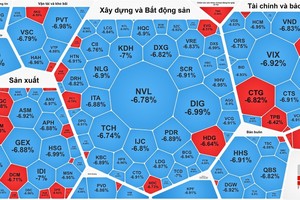 |
Vina T&T Group, specializing in exporting dragon fruits, is partnering up with farmers for stable produce price |
Compared to traditional produce in the country like orange or pineapple, aloe vera has only become a favorable crop for the last 10 years, but has quickly been chosen to be the key merchandise of Ninh Thuan Province.
Operating for over 10 years, the aloe vera farm of Truong Thi Phuong from Phan Rang City of Ninh Thuan Province has always been saleable because she is cooperating with GC Food Co., which aids her in planting the crop in accordance with international standards and ensures her output.
Thanks to a stable input source, the aloe vera processing factory of GC Food Co. is always working at full capacity of 35,000 tonnes per year. Its products are then sold directly to the market or become the material for various domestic cosmetics companies to sell the end-products in global markets like Japan, the Republic of Korea (RoK), EU, and the US.
Sharing a similar working model is Chanh Thu Fruit Import-Export Group JSC., which is now a partner of several produce cooperatives. It has built cold storages and processing plants for durian in the provinces of Dak Lak and Tien Giang, for coconut and grapefruit in the provinces of Ben Tre and Tien Giang. It is helping farmers to apply international standards in their plant growing process for ease of export.
Another successful case is Hoang Hau Dragon Fruit Co. Ltd., which is now collaborating with orchards to grow dragon fruits that meet GAP standards to export to picky markets of EU, the US, Japan, and RoK. The company also invests in modern fruit dryers to diversify its products.
One more such successful partnership is between Thanh Phu Long Agricultural Cooperative in Long An Province with Nafood Group JSC., TaniFood Fruit Processing Factory (sited in Tay Ninh Province), and many supermarkets nationwide.
Statistics from the Agriculture and Rural Development Ministry reveal that in the 2013-2018 period, the nation’s produce processing industry witnessed a strong development with an annual growth rate of 5-7 percent and an annual rise of exported produce volume by 8-10 percent for many years. Vietnam has basically formed its agricultural product processing system with over 7,500 plants for export purposes, along with thousands ones to answer domestic demands.
Since 2018, many major corporations have invested in 30 produce processing projects that can satisfy international requirements on product quality and food sanitation in order to sell in the markets of EU, the US, Japan.
 |
GC Food Co. is partnering up with farmers for a circular agricultural system |
Director Nguyen Nhu Cuong of the Crop Production Department (under the Agriculture and Rural Development Ministry) stressed that a partnership for large-scale farming and produce processing greatly contributes to stabilizing the output for farmers. His Ministry has introduced the project ‘Developing Key Fruit Trees in the 2025-2030 Period’ to give better directions for local authorities, farmers, and businesses in the field to follow.
Insisting that the role of local authorities is extremely important in warning farmers of possible risks of unplanned crops and delivering plant growing instructions, Director Cuong further informed that his Department is going to research and recommend fruit trees suitable for the climate, soil, and water of each area.
Experts in the field agreed with Director Cuong on the necessity to form collaboration between farmers and produce processing businesses, with clear strategies based on the market demands and capacity of each partner.
Those experts proposed that besides aiding farmers, the Government should introduce proper policies to support small and medium-sized enterprises in their investment in food processing lines and produce preservation to reduce the pressure on fresh fruit consumption.
Any orchards not following the planning should not receive support from the local authorities, neither granting planting area codes nor investing in infrastructure, forming ‘One Commune One Product’. Serious violations must even be punished.
Finally, the Government is proposed to help agricultural cooperatives to construct refrigerated containers for farmers to temporarily store their crops there if unsold yet. These useful storages can save fresh products for as long as 3 months. When produce prices are higher, the earned profit can be used to pay for container operation cost.
The agriculture sector sets a goal that by 2023, the proportion of value of the produce processing industry will have accounted for 30 percent of the national GDP. The growth rate of value of processed produce will have been 7-8 percent a year. Over 50 percent of all produce processing factories can satisfy export requirements.
























